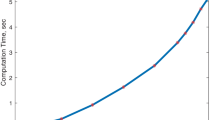Abstract
Up till now, among the numerical computation methods of the spherical harmonic perturbation on an artificial satellite, the computation speed of Cunningham's method is the fastest. However, running programs based on this method easily causes overflow. A method is presented, which has a computation speed higher than that of any other methods, and can avoid overflow in operation, even when the order and degree of the Earth's spherical harmonic perturbation are extended to 100×100 or more. It satisfies the requirements of the high-accuracy SLR, GPS, LLR, etc. This method has been programmed and used in practice. Now a large-scale calculation related to the satellite precision ephemeris could be done just with a microcomputer.
Similar content being viewed by others
References
Lin Qinchang, Yang Fumin, Tan Detonget al., The preprocessing of the satellite laser ranging data,Annals of Shanghai Observatory (in Chinese), 1981, 3: 205.
Yang Fumin, Tan Detong, Xiao Chikunet al., The third-generation satellite laser ranging system at Shanghai Observatory, inProceedings of International Conference on Opto-Electronic Science and Engineering (ICOESE) (ed. Wang Daheng), SPIE Proc. Ser., Vol. 1230, Bellingham: SPIE, 1990, 144–147.
Tan Detong, Yang Fumin, Xiao Chikunet al., ETALON satellite laser ranging at Shanghai Observatory,Acta Astronomica Sinica (in Chinese), 1992, 33(3): 246.
Lin Qinchang, Huang Tianyi, Tesseral terms derived with computer,Acta Astronomica Sinica (in Chinese), 1979, 20 (2): 105.
Cunningham, L. E., On the computation of the spherical harmonic terms needed during the numerical integration of the orbital motion of an artificial satelite,Celestial Mechanics, 1970, 2: 207.
Jekeli, C., The exact transformation between ellipsoidal and spherical harmonic expansions,Manuscripta Geodaetica, 1988, 13: 106.
Liu Lin,Orbital Mechanics of Artificial Satellites (in Chinese), Beijing: Higher Education Press, 1992, 114.
Meng Jiachun, Liu Shangyu, Research on accuracies for satellite gravity gradiometry and Earth's gravitational field.Chinese Journal of Geophysics (in Chinese), 1994, 37(1): 39.
Author information
Authors and Affiliations
Additional information
Project supported by the National Natural Science Foundation of China and the Natural Science Foundation of Guangdong Province.
Rights and permissions
About this article
Cite this article
Lin, Q. Fast computation of the spherical harmonic perturbation on an artificial satellite. Sci. China Ser. E-Technol. Sci. 40, 324–330 (1997). https://doi.org/10.1007/BF02916608
Received:
Issue Date:
DOI: https://doi.org/10.1007/BF02916608




